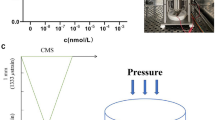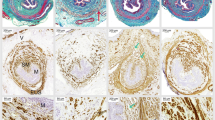Abstract
Purpose
The roles of estrogen receptor α (ERα) in stress urinary incontinence (SUI) remain elusive. This study was conducted to understand the molecular mechanism of ERα against SUI.
Methods
Wild-type (ERα+/+) and ACTB-cre ERα knockout (ERα−/−) female mice were generated. Urethral function and protein expression were measured. Leak point pressures (LPP) and maximum urethral closure pressure (MUCP) were assessed in mice under urethane anesthesia. After the measurements, the urethras were removed for proteomic analysis using the two-dimensional differential gel electrophoresis and liquid chromatography–mass spectrometry technology. Interaction between these ERα pathway proteins was further analyzed by using MetaCore. Lastly, Western blot and immunochemistry (IHC) were used to confirm the candidate protein expression levels and locations, respectively.
Results
Compared with the ERα+/+ group, the LPP and MUCP values of the ERα−/− group were significantly decreased. Additionally, we identified 11 differentially expressed proteins in the urethra of ERα−/− female mice; five proteins were down-regulated and six were up-regulated. The majority of the ERα knockout-modified proteins were involved in muscle development, contraction, and regulation, as well as immune response (amphoterin signaling and phagocytosis), proteolysis, and cell adhesion (platelet aggregation and integrin-mediated cell–matrix adhesion). IHC and Western blot confirmed the down-regulation of tropomyosin and up-regulation of myosin in urethra.
Conclusions
This is the first study to estimate protein expression changes in urethras from ERα−/− female mice. These changes could be related to the molecular mechanism of ERα in SUI.







Similar content being viewed by others
References
Phe V, Nguyen K, Roupret M, Cardot V, Parra J, Chartier-Kastler E (2014) A systematic review of the treatment for female stress urinary incontinence by ACT(R) balloon placement (Uromedica, Irvine, CA, USA). World J Urol 32(2):495–505. doi:10.1007/s00345-013-1117-0
Bo K (2012) Pelvic floor muscle training in treatment of female stress urinary incontinence, pelvic organ prolapse and sexual dysfunction. World J Urol 30(4):437–443. doi:10.1007/s00345-011-0779-8
Zhu L, Lang J, Feng R, Chen J, Wong F (2004) Estrogen receptor in pelvic floor tissues in patients with stress urinary incontinence. Int Urogynecol J Pelvic Floor Dysfunct 15(5):340–343. doi:10.1007/s00192-004-1178-0
Shapiro LF, Freeman K (2014) The relationship between estrogen, estrogen receptors and periodontal disease in adult women: a review of the literature. N Y State Dent J 80(3):30–34
Curtis Hewitt S, Couse JF, Korach KS (2000) Estrogen receptor transcription and transactivation: estrogen receptor knockout mice: what their phenotypes reveal about mechanisms of estrogen action. Breast Cancer Res 2(5):345–352
Lubahn DB, Moyer JS, Golding TS, Couse JF, Korach KS, Smithies O (1993) Alteration of reproductive function but not prenatal sexual development after insertional disruption of the mouse estrogen receptor gene. Proc Natl Acad Sci U S A 90(23):11162–11166
Hirai K, Tsuda H (2009) Estrogen and urinary incontinence. Int J Urol 16(1):45–48. doi:10.1111/j.1442-2042.2008.02164.x
Sievert KD, Emre Bakircioglu M, Tsai T, Dahms SE, Nunes L, Lue TF (2001) The effect of simulated birth trauma and/or ovariectomy on rodent continence mechanism. Part I: functional and structural change. J Urol 166(1):311–317
Ma WL, Jeng LB, Yeh CC, Chang C (2012) Androgen and androgen receptor signals jamming monocyte/macrophage functions in premalignant phase of livers. Biomedicine 2(4):155–159
Liu X, Zhao Y, Gao J, Pawlyk B, Starcher B, Spencer JA, Yanagisawa H, Zuo J, Li T (2004) Elastic fiber homeostasis requires lysyl oxidase-like 1 protein. Nat Genet 36(2):178–182. doi:10.1038/ng1297
Hammack BN, Fung KY, Hunsucker SW, Duncan MW, Burgoon MP, Owens GP, Gilden DH (2004) Proteomic analysis of multiple sclerosis cerebrospinal fluid. Mult Scler 10(3):245–260
Chen M, Wolfe A, Wang X, Chang C, Yeh S, Radovick S (2009) Generation and characterization of a complete null estrogen receptor alpha mouse using Cre/LoxP technology. Mol Cell Biochem 321(1–2):145–153. doi:10.1007/s11010-008-9928-9
Chen M, Yeh CR, Chang HC, Vitkus S, Wen XQ, Bhowmick NA, Wolfe A, Yeh S (2012) Loss of epithelial oestrogen receptor alpha inhibits oestrogen-stimulated prostate proliferation and squamous metaplasia via in vivo tissue selective knockout models. J Pathol 226(1):17–27. doi:10.1002/path.2949
Chen HY, Chen CJ, Lin YN, Chen YH, Chen WC, Chen CM (2013) Proteomic analysis related to stress urinary incontinence following vaginal trauma in female mice. Eur J Obstet Gynecol Reprod Biol. doi:10.1016/j.ejogrb.2013.08.034
Liu PL, Tsai JR, Chiu CC, Hwang JJ, Chou SH, Wang CK, Wu SJ, Chen YL, Chen WC, Chen YH, Chong IW (2010) Decreased expression of thrombomodulin is correlated with tumor cell invasiveness and poor prognosis in nonsmall cell lung cancer. Mol Carcinog 49(10):874–881. doi:10.1002/mc.20663
Yang TL, Lin FY, Chen YH, Chiu JJ, Shiao MS, Tsai CS, Lin SJ, Chen YL (2011) Salvianolic acid B inhibits low-density lipoprotein oxidation and neointimal hyperplasia in endothelium-denuded hypercholesterolaemic rabbits. J Sci Food Agric 91(1):134–141. doi:10.1002/jsfa.4163
Chen HY, Lin YN, Chen YH, Chen WC (2012) Stress urinary incontinence following vaginal trauma involves remodeling of urethral connective tissue in female mice. Eur J Obstet Gynecol Reprod Biol 163(2):224–229. doi:10.1016/j.ejogrb.2012.04.012
Game X, Allard J, Escourrou G, Gourdy P, Tack I, Rischmann P, Arnal JF, Malavaud B (2008) Estradiol increases urethral tone through the local inhibition of neuronal nitric oxide synthase expression. Am J Physiol Regul Integr Comp Physiol 294(3):R851–R857. doi:10.1152/ajpregu.00467.2007
Nevzorov IA, Levitsky DI (2011) Tropomyosin: double helix from the protein world. Biochemistry (Mosc) 76(13):1507–1527. doi:10.1134/S0006297911130098
Athanasiou S, Lymberopoulos E, Kanellopoulou S, Rodolakis A, Vlachos G, Antsaklis A (2010) Proteomic analysis of pubocervical fascia in women with and without pelvic organ prolapse and urodynamic stress incontinence. Int Urogynecol J 21(11):1377–1384. doi:10.1007/s00192-010-1203-4
Procaccio V, Depetris D, Soularue P, Mattei MG, Lunardi J, Issartel JP (1997) cDNA sequence and chromosomal localization of the NDUFS8 human gene coding for the 23 kDa subunit of the mitochondrial complex I. Biochim Biophys Acta 1351(1–2):37–41
Chang C, Chang AY, Chan SH (2004) De novo synthesis of ubiquitin carboxyl-terminal hydrolase isozyme l1 in rostral ventrolateral medulla is crucial to survival during mevinphos intoxication. Shock 22(6):575–581
Lazarides E, Hubbard BD (1976) Immunological characterization of the subunit of the 100 A filaments from muscle cells. Proc Natl Acad Sci U S A 73(12):4344–4348
Scott RS, Li Z, Paulin D, Uvelius B, Small JV, Arner A (2008) Role of desmin in active force transmission and maintenance of structure during growth of urinary bladder. Am J Physiol Cell Physiol 295(2):C324–C331. doi:10.1152/ajpcell.90622.2007
Bommer UA, Thiele BJ (2004) The translationally controlled tumour protein (TCTP). Int J Biochem Cell Biol 36(3):379–385
Cooke JP (2004) Asymmetrical dimethylarginine: The Uber marker? Circulation 109(15):1813–1818. doi:10.1161/01.CIR.0000126823.07732.D5
Grill B, Wilson GM, Zhang KX, Wang B, Doyonnas R, Quadroni M, Schrader JW (2004) Activation/division of lymphocytes results in increased levels of cytoplasmic activation/proliferation-associated protein-1: prototype of a new family of proteins. J Immunol 172(4):2389–2400
Dissaranan C, Cruz MA, Kiedrowski MJ, Balog BM, Gill BC, Penn MS, Goldman HB, Damaser MS (2014) Rat mesenchymal stem cell secretome promotes elastogenesis and facilitates recovery from simulated childbirth injury. Cell Transplant 23(11):1395–1406. doi:10.3727/096368913X670921
Acknowledgments
We are grateful for the technical assistance of Miss Chi-Hsiang Wei. This work was supported in part by Taiwan Ministry of Science and Technology (NSC 103-2911-I-002-303, NSC101-2632-B039-001-MY3, NSC101-2314-B-039-018, and NSC102-2320-B-039-025), China Medical University Hospital (DMR-104-058), National Health Research Institutes (NHRI-EX102-10241BI), CMU under the Aim for Top University Plan of the Taiwan Ministry of Education, and Taiwan Ministry of Health and Welfare Clinical Trial and Research Center of Excellence (MOHW103-TDU-B-212-113002 and MOHW104-TDU-B-212-113002).
Conflict of interest
The authors have no conflicts of interest to disclose.
Ethical standard
The procedures of the animal study received approval from the ethical committee of the Institutional Animal Care and Use Committee of China Medical University (Reference number: 101-201-N, Date: Feb. 3, 2012).
Author information
Authors and Affiliations
Corresponding authors
Additional information
Y.-H. Chen and C.-J. Chen contributed equally to this study.
Rights and permissions
About this article
Cite this article
Chen, YH., Chen, CJ., Lin, YN. et al. Proteomic analysis of urethral protein expression in an estrogen receptor α-deficient murine model of stress urinary incontinence. World J Urol 33, 1635–1643 (2015). https://doi.org/10.1007/s00345-014-1474-3
Received:
Accepted:
Published:
Issue Date:
DOI: https://doi.org/10.1007/s00345-014-1474-3




